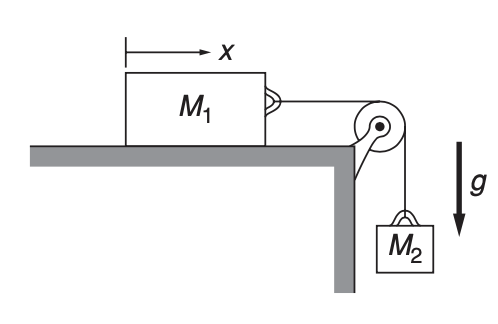Vivek's answer is correct and neat. I want to complement it with a slightly more realistic picture of the problem and pointing out why some approximations are made, in case this is what you're trying to understand better. I'll come to the tension towards the end.
If we consider a very thin segment of rope at the pulley and simplify in 2D, the situation of the surface forces exerted on the segment is roughly as illustrated in this picture:

On one short side there's a compressive force exerted by the pulley; there's no tangential component because we consider a frictionless pulley. On the other short side there's no force (except negligible air pressure).
On the lower side – side 1 – we have a field of tensile surface forces. They're larger away from the pulley because the rope is more stretched there. (The picture may actually be slightly wrong in that the forces closer to the pulley maybe are compressive, directed inwards. But the general analysis below is still valid even in that case.) Moreover, they're not quite perpendicular to the surface, but have a tangential component directed towards the pulley, because the segment must be subjected to a slight shear as it turns around the pulley. Also, without this tangential component the rope would fly away from the pulley, as you can see in the equations below. I'm neglecting the force of gravity.
On the upper side – side 2 – we have another field of tensile surface forces, again larger away from the pulley, and slightly directed towards the pulley.
Let's skip the rotational motion of the segment and focus on its linear motion. Then, to calculate the acceleration of (the mass-centre of) the segment, we just need to vectorially sum all these forces, irrespectively of where they are applied. In view of this let me first sum the forces on each side separately, and decompose them according to the coordinates depicted in the picture below. Coordinate $x$ is meant to be tangential/"along" the axis of the rope, coordinate $y$ orthogonal to it:

If $m$ is the mass of the segment, the balance of momentum has the two component equations
$$m a_x = F_x + G_x \ ,$$
$$m a_y = R_y + F_y + G_y \ .$$
Now, if the mass of the segment is negligible with respect to the other masses present in the bigger problem: $m \approx 0$, and the acceleration is finite, we approximately find
$$G_x \approx - F_x \ ,$$
$$ G_y \approx - R_y - F_y\ .$$
The approximate equations are for the total forces on the two sides.
If our final goal were to calculate the motion of the segment, it would be silly to make these approximations, of course, because we would make the balance of momentum indeterminate: $0\ a = 0$, without hope of finding $a$. But our goal is to find the motion of other larger masses involved in the problem, on which other forces act (gravity etc); and these other forces can be quite different from $F$ and $G$ above. Therefore a small difference between the magnitudes of $F$ and $G$ can be simply neglected in view of the bigger picture.
So, in the context of the bigger picture, we find that the normal components of the surface forces on sides 1 and 2 are approximately equal and opposite.
Let's calculate the (average) stress tensor at the sides 1 and 2. This tensor, represented here by a 2-by-2 symmetric matrix, takes the normal as input and yields the resulting force. For side 1 the normal is $\pmb{e}_x \equiv \begin{pmatrix}1\\0\end{pmatrix}$ and the stress tensor $\pmb{\tau}^{(1)}$ there must therefore satisfy
$$\begin{pmatrix}F_x\\F_y\end{pmatrix} =
\begin{pmatrix} \tau_{xx} & \tau_{xy}\\
\tau_{xy} & \tau_{yy}\end{pmatrix}
\begin{pmatrix}1\\0\end{pmatrix}
\quad\Longrightarrow\quad
\pmb{\tau}^{(1)} = \begin{pmatrix} F_x & F_y\\
F_y & \tau^{(1)}_{yy}\end{pmatrix}
\ .$$
Analogous reasoning for side 2 (with normal $-\pmb{e}_x$) and considering the approximate equalities above yields (note that there are two minus signs giving a plus):
$$\pmb{\tau}^{(2)} \approx \begin{pmatrix} F_x & F_y + R_y\\
F_y + R_y & \tau^{(2)}_{yy}\end{pmatrix} \ . $$
When we approximate the rope as a 1D string, we're neglecting the $y$ components of the stress, and the leftover $\tau_{xx}$ component is called the "tension". We thus find
$$ \tau^{(2)}_{xx} \approx \tau^{(1)}_{xx}=F_x$$
or equivalently, dividing by the thickness $\Delta x$ of the segment, we find $\frac{\partial \tau_{xx}}{\partial x} \approx 0$, as derived in Vivek's answer. The tension is (approximately) constant throughout the rope. Note, however, that the cross-components of the stress $\tau_{xy}$ are not constant along the segments that touch the pulley (see below for the remaining segments); they express the fact that the rope-pulley system is "changing the direction of the force transmitted through the rope".
This approximation cannot be made if we have kilometres of rope, of course, because the small differences in the opposite surface forces add up to a non-negligible contribution to the bigger problem. This is equivalent to saying that the total mass of the rope becomes non-negligible.
The full analysis can reveal other details that are unimportant for the bigger problem. For example, if the segment touching the pulley is moving downwards, there must be a change in the direction of its velocity, towards $-y$. This means that we must have $a_y <0$ and therefore $R_y < - F_y - G_y$. The approximate analysis just made is also correct for horizontal or vertical segments of rope, away from the pulley. In that case we find that $a_y=0$ and $0=R_y=F_y =G_y$.
For further understanding you can check what happens if the pulley has friction, so that we must add a tangential force on the short side of the segment.





